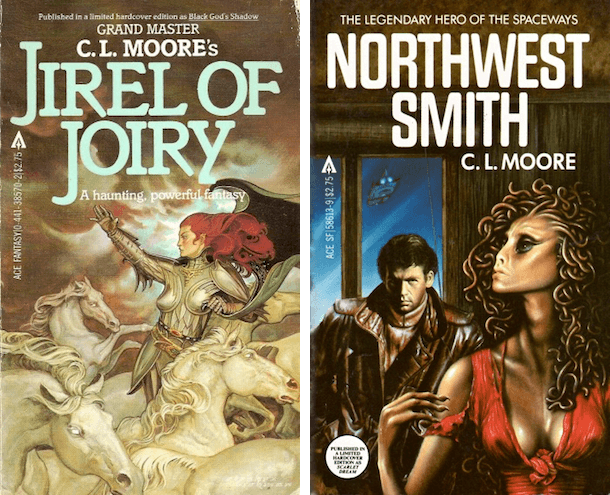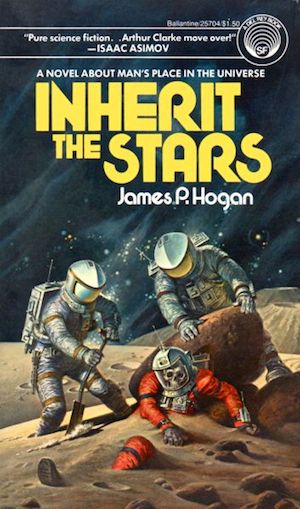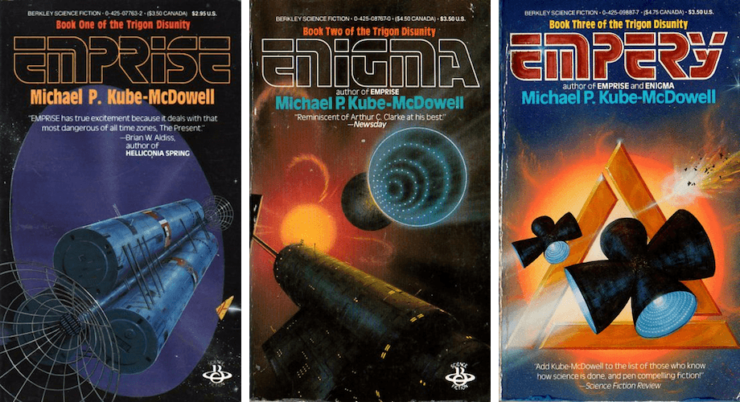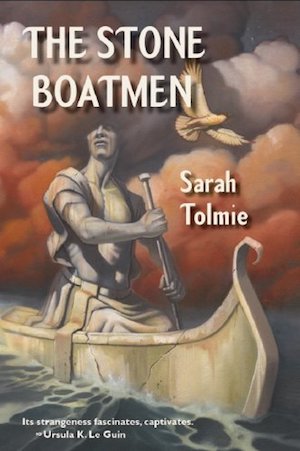As previously discussed, it’s possible to do such a thorough job of destroying a civilization that all knowledge of it is lost…at least until inexplicable relics start to turn up. One example: the real world Indus Valley Civilization, which might have flourished from 3300 to 1300 BC, across territory now found in western and northwestern India, Pakistan and northeastern Afghanistan. It was contemporaneous with the civilizations of Ancient Egypt, Mesopotamia, and China. History did a thorough enough job of erasing the Indus Valley Civilization from the records that when modern archaeology began to study it, it wasn’t at all clear whose ruins were being explored1. It just goes to show that no matter how great a civilization might be, time is greater.
Thanks to the exploits of 19th-century archaeologists (many of them no better than Indiana Jones, digging for statues and jewelry while ignoring evidence of daily life), lost civilizations were common features of 19th-century adventure stories. The trope was imported wholesale into early SFF. Do you remember your first SFF lost civilization? I remember mine, which was thanks to Scholastic Books: the enthusiastically pulp-ish Stranger from the Depths, by Gerry Turner.
A mysterious relic reveals to humanity that there was an ancient civilization that arose before modern humans evolved in Africa. “Was”…or “is”? Ancient does not always mean vanished. These ancient aliens have, in fact, survived(!!!) in well-concealed refugia. Humans have now stumbled across them. Will humans survive the discovery?
Here are a few of my favourite SFF lost civilizations:

C. L. Moore’s Jirel of Joiry and Northwest Smith inhabit settings that are two thousand years apart. Jirel’s people live in a world they believe to be demon-haunted. Smith’s people have arrived at a different conclusion.
Man has conquered Space before, and out of that conquest faint, faint echoes run still through a world that has forgotten the very fact of a civilization which must have been as mighty as our own.
The evidence in the stories suggests that not only were creatures other than Men responsible for some of those forgotten civilizations, but that Jirel was not so very far off the mark when she thought demons haunted the relics of the past. And for the record, I would like to note (again) that while Jirel faces her challenges with bravery, determination, and cunning, Northwest is a dim-witted genre-blind charmer who strides obliviously into traps and lets his women die to save him.

James P. Hogan’s first novel2, Inherit the Stars, reads more like 1940s puzzle SF than the Disco-era book that it is, but it was still a diverting debut. 21st-century humanity is faced with a seemingly insoluble mystery: a 50,000-year-old space-suited human corpse on the Moon. The age of the body is undeniable, but so is the fact that there is no evidence on Earth of a civilization capable of putting a man on the Moon 50,000 years ago. At the same time, humans are clearly the product of a terrestrial evolutionary lineage hundreds of million of years old. How to reconcile the irreconcilable?

In Michael P. Kube-McDowell’s Trigon Disunity trilogy, the Earth receives mysterious signals from the stars and sends out its first interstellar mission to seek their origin. The expedition finds extra-solar colonies that are clearly the last remnant of a star-spanning civilization that has otherwise disappeared. What erased this civilization? And how can humans prevent a repeat?

Enigmatic relics provide both the title of Sarah Tolmie’s remarkable debut novel, The Stone Boatmen, and evidence that some great civilization once spanned the world. The ship Aphelion sets out to discover what it can, in the process discovering that there are at least two other cultures (in addition to the city that launched Aphelion) that are also amnesiac children of that great vanished power. Ages of isolation have insured that the three cultures will develop in very different ways. The novel’s braided stories spin a gentle tale of lost cousins rediscovering family, one enchanting enough to earn a glowing blurb from Ursula K. Le Guin herself.
I am certain some of you are astounded that I didn’t mention some old classic—She, for example, or a widely beloved Edgar Rice Burroughs’ Tarzan novel3. Embrace what’s apparently the custom and point out my egregious oversight in comments!
Originally published July 2019.
In the words of Wikipedia editor TexasAndroid, prolific book reviewer and perennial Darwin Award nominee James Davis Nicoll is of “questionable notability.” His work has appeared in Publishers Weekly and Romantic Times as well as on his own websites, James Nicoll Reviews and Young People Read Old SFF (where he is assisted by editor Karen Lofstrom and web person Adrienne L. Travis). He is a finalist for the 2019 Best Fan Writer Hugo Award, and is surprisingly flammable.
[1]Archaeologists can be quite resistant to explanations that conflict with cherished origin myths or racist presuppositions. Earlier archaeologists tied themselves in knots trying to find an explanation for Great Zimbabwe that didn’t involve giving the credit for the impressive structures to Africans.
[2]Hogan began his career as a hard-SF author whose prose was never better than serviceable but whose settings and plots could be diverting. He ended it embracing some intensely dubious and troubling scientific and political opinions, so I would recommend avoiding his later, post-'90s work—the joke at the time was that Hogan turned out to be Y2K incompatible.
[3]I have never read any Tarzan novels but I am absolutely certain at least one lost civilization must turn up in one novel or another.











A classic of the lost civilization genre: David Macauley’s Motel of the Mysteries
https://www.goodreads.com/book/show/108831.Motel_of_the_Mysteries?ac=1&from_search=true&qid=evWj44KXlK&rank=1
“Total Eclipse” by John Brunner is about exploring the remains of alien civilization on a different world.
The relics of ancient civilizations in Heinlein’s “Lost Legacy” hasn’t left physical artifacts, but it’s still possible to learn about them.
I maintain that the Star Wars universe doesn’t make any sense without the existence of the Celestials; an ancient galaxy-spanning civilization that (I hypothesize) created the midi-chlorians through nanotechnology as a user-interface for their Force-harnessing technology –leaving the Jedi and the Sith as the (unwitting) inheritors of their long-fallen civilization.
Omnilingual, by Piper … long short story or short novellette, but a solid piece of work with a memorable woman professional as the protagonist, and an international/race/gender cast of characters, and from 1957:
https://www.tor.com/2012/03/05/scientific-language-h-beam-pipers-qomnilingualq/
Old Mars, obviously, but a thoughtful science puzzle story, with some slam bang adventure but no BEMs,
And, as has been said, it passes the Bechdel test in the second scene.
http://www.gutenberg.org/files/19445/19445-h/19445-h.htm
Paul McAuley does this with his Jackaroo series. Vinge does it as well with Fire Upon the Deep.
Andre Norton’s Forerunners leap forcefully to mind. An ancient, hubristic civilization with innumerable nightmarish lethal legacies that sound suspiciously like nuclear-waste disposal sites; tech so advanced even the Zacathans don’t grok it, those long-lived egg-headed lizard-librarians…classic stuff of planet-wide machines “waking up” to finish their incomprehensible and malign purposes. Today’s crop includes Tim Pratt’s Axiom trilogy. Really, you can’t beat Those Who Went Before as the richest seam of handwavium in SF.
In Brin’s Startide Rising, everyone knows there were Precursors, but no one agrees on the details, which makes the Precursor artifact found by Terrans a political hot potato.
In the Mass Effect video game series, everyone has bootstrapped off the tech and infrastructure attributed to the vanished Protheans. But until discoveries made by the protagonist, no one knows how many layers deep the vanished civilizations go, or what that means for the prospects of the current one.
Been fascinated by lost civilizations for almost as long as I can remember. My earliest might have been Middle Earth, which I don’t think tends to get classified as such, but clearly qualifies by presenting itself as a vast epoch forgotten by conventional history. Robert E. Howard’s Hyborian Age was another (and a creation whose brilliance and originality are, in my opinion, under-appreciated).
@3: That, and the ancient ones must also have been into made-to-order ecosystems, which would explain otherwise utterly bananas planets like Naboo. Nobody’s maintaining them, though, which explains Hoth’s runaway Ice Age. But the people of the GFFA have no idea that their planets were engineered, or else there are a few cultures that realize that their particular planet was sculpted by somebody, but they don’t realize how widespread it was.
This subject is near and dear to my heart. My imagination was really captured by the Silurian Hypothesis, a thought experiment concerning the methods by which we would be able to detect the presence of a millions-year-old advanced civilization. Geologic processes would have long destroyed any cities, so the clues would lie in isotope ratios and other chemical clues. How long would one of our modern skyscrapers last if no maintenance were being done on it? In contrast, the oceanic plastic garbage gyres will probably result in a band in ocean sediments comparable to the iridium layer that was the smoking gun in the Great Dinosaur Murder Case of 65mya.
@6. An ancient, hubristic civilization with innumerable nightmarish lethal legacies that sound suspiciously like nuclear-waste disposal sites There’s another thought experiment that fascinates me… how would we mark these sites so that future civilizations could know that they are deadly?
@8. In my headcanon, the Hyborian Age is a distant sequel to LotR… a sort of Fourth Age written before even The Hobbit was published. The Cimmerians are the descendants, by way of the Atlanteans, of the people of Gondor. The Stygians are descendants of the Haradrim. Even remnant populations of orcs live on as the various ‘gray apes’ and ‘ape-men’ of the hinterlands.
It doesn’t matter how we mark nuclear waste sites. Our descendants WILL dig them up because they’ll want to know what we were so scared of.
I always liked the Silverberg juvenile “Across A Billion Years”. The story is not without it’s flaws, especially by modern standards, but the sweep of a civilization from that long ago that suddenly might still actually be there? It would be like the Trilobite necklace I have coming back to life and it’s only a HALF a billion years old :D
@10 Kirth Girsome Wonderful idea.
also @10 Howard’s Cimmerians are also descended from Atlanteans, albeit counter-stereotpical ones that never evolved a high civilization. Maybe Howard’s ‘Thurian Age’ Atlantis represents an un-sunk fragment of Numenor, or a portion of it that re-emerged from the ocean for an epoch, before sinking again for a final (?) time.
I enjoyed a series of books about a space archaeologist, written by Allen L. Wold, which included Jewels of the Dragon, Crown of the Serpent and The Lair of the Cyclops. They were fun in a pulpy, adventurous vein. And Michael Flynn’s The January Dancer, and the books that followed it, centered on a McGuffin that was an artifact from an ancient race. Wasteland of Flint by Thomas Harlan is another excellent book that centers on an interstellar archaeologist, in a fascinatingly strange future culture.
There are also scads of books set after an apocalypse, where the ancient artifacts being unearthed are from our current civilization.
You blew it up! Damn you! God damn you all to hell!
Stranger From the Depths! I’ve never encountered anyone else who had read it! It was amongst the books at my grandparent’s cabin and I read it several summers.
I read the Trigon Disunity when I was much younger, and remember very little. I was thrilled recently to find all three books in a used bookstore.
I think The Malazan Book of the Fallen deserves a place in this thread. The author, Steven Erikson, is an archaeologist, and the impact of ancient civilizations on his world is prominent.
@3 That sounds like what I understand the Whills to be, though with Lucas having stepped away we may never find out what his vision in that regard was.
@15 A Canticle for Liebowitz comes to mind.
@17 Derek Baker
I LOVED that book and tried unsuccessfully for YEARS to remember the title – imagine my delight when JDN just casually tossed it out for me…
Heinlein also touched on this in some of the juveniles. In “Rocket Ship Galileo,” the explorers discover caves on the Moon that appear to have been made by some sort of civilization. And in “Space Cadet,” there’s reference to studying about the “Selenites,” a long-vanished Lunar civilization, as well as the discovery that the asteroid belt was actually the debris of a planet that had been somehow destroyed by its inhabitants. In “Farmer in the Sky,” there’s the discovery on a terraformed Ganymede of a “hangar for spaceships” left by some vanished civilization or interstellar visitors that still houses a working all-terrain vehicle resembling a mechanized centipede.There may be others, but those are the ones I can remember right now.
@Russell H/20 — In Red Planet (and maybe Stranger in a Strange Land?), there’s mention that the missing fourth planet was actually destroyed by the Martians, IIRC, after some provocation. Although I’m not sure if RP is happening in quite the same future as RSG and SC.
I also have happy memories of reading Alan E.Nourse’s Scavengers in Space, another book where asteroid miners discover that the asteroids are fragments of a previously-inhabited world.
@21 You mean the fifth planet was destroyed, not the fourth, which is Mars herself. That was a common theory back in the 50s and 60s, and very popular with SF writers of the era. I loved stories that included that concept.
Interestingly, computer modeling has recently suggested that there might have been a Planet V, a small planet that went eccentric, and wandered through the Asteroid Belt before it finally crashed into the Sun, and created something called the Late Heavy Bombardment, which left a lot of the craters we now see on the moon. Search for Planet V on Wikipedia for more details.
@22 AlanBrown
But WHY DID IT GO ECCENTRIC? What were the inhabitants doing???
Great fodder for stories, indeed.
OMG yes! Stranger From The Depths! This was one of the books that made me a SF fan. (I, too, have never met anyone else who read it.)
@22 — Yes, fifth — I was having trouble counting, apparently … :)
@various Heinlein juveniles discussion: towards the end of Have Space Suit—Will Travel, there is mention of a First Empire (First Federation? First something, I neglected to check my copy when I was home for lunch) which lost a ship somewhere in the vicinity of Terra way back when, and the science macguffin in Between Planets was indiana jonesed from ancient ruins on Mars.
Douglas Muir pointed out that any industrial civilization similar to ours would leave obvious traces from mining. They’d dig big holes in ore deposits literally billions of years old, and the holes would fill up with easily recognizable sediment.
@27 but how long would it take tectonic shifts to eradicate much or all of the the evidence?
Longer than you’d think. The biggest gold deposit in the world is two billion years old. It’s shifted around the world with tectonic activity, and been buried and uncovered a few times, but nothing has dispersed it. The same would apply if any previous civilization mined it and it filled with sediment. Maybe they didn’t get to it, or they weren’t interested in gold, but you can use the same logic on almost every other ore deposit.
This story https://www.vice.com/en_us/article/3kj4y8/gavin-schmidt-fiction-under-the-sun talks about detecting truly ancient civilizations.
Accidental duplicate.
Tolkien, of course, with both the Eldar and Gondor.
Nobody else wants to mentioned the Greek ideas of the Golden and Silver ages before their then-current age of base metal?